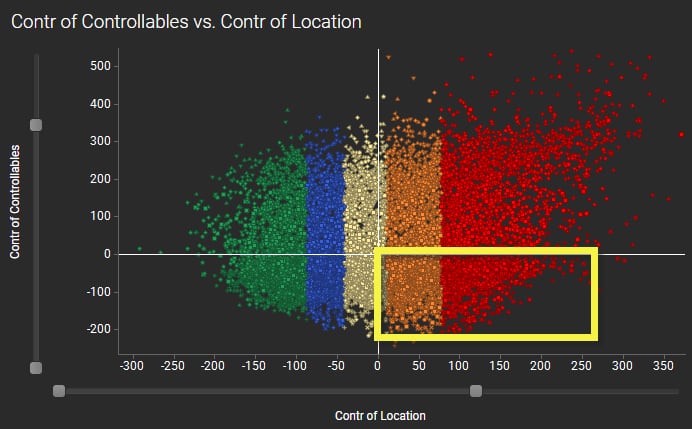Artificial Intelligence: New techniques for understanding basin performance drivers
Artificial Intelligence (AI) predictive models work to help engineers in Upstream E&P gain actionable insights from complex models and develop better asset strategies. The IHS Markit models are intuitive and can analyze vast amounts of data rapidly and provide interpretability capabilities to help engineers better understand the model results.
With customizable models, engineers can choose which basin attributes (production, completions, well, etc.) they want to evaluate for identifying basin performance drivers. Additionally, they can incorporate proprietary datasets, validate results and rerun their predictive models as more data and knowledge accumulates.
Attribute Analysis
Analytics Explorer's predictive modeling techniques make it easy to visualize and analyze an entire asset's data. Users can incorporate their own company data and customize the data inputs based on domain expertise.
Attribute analysis is the first step in creating a predictive performance model. This function evaluates specified well data and ranks attributes by importance. Attributes can include items like well location, target formation, well path, proppant volume, spacing, relevant geologic or geophysical data, and more. The most important attributes have the greatest impact on well performance, while the least important attributes have a negligible impact. For each attribute, the models output detailed information about how the inclusion of that attribute affects the predictability of the model. This enables users to exclude irrelevant or redundant attributes and open themselves to surprises about overlooked variables.
Analytics Explorer's error analysis algorithms determine the optimal number of attributes for each model. Removing these attributes that do not reduce error streamlines the modeling process.
What's Controlling the Asset?
In addition to ranking attributes by importance, Analytics Explorer also allows for users to group like features together when diving into what is controlling the asset.
For example, clients often want to group attributes driven by geology, as they are essentially non-controllable. Examples include:
- Well location (latitude and longitude)
- Acreage quality
- Formation thickness
- Depth to formation
Engineering decisions, on the other hand, may include controllable and conscious decisions made by the company that can be optimized:
- Lateral length
- Frac stages
- Fluid and proppant volume
- Well spacing

The most important attributes have the greatest influence on well performance, while the least important attributes have a negligible impact. Here, well location has the most impact on performance. Attributes in orange are controllable and attributes in blue are non-controllable.
Detailed insight about performance drivers can help guide asset development decisions. If an underperforming asset's performance is largely driven by non-controllable factors, engineers can determine which controllable factors can be optimized to increase production. If a high-performing asset is driven by geology, engineers can model different completions scenarios to further optimize production or reallocate capital to maximize returns.
Using Predictive Models
The predictive models generated in Analytics Explorer come together in a matter of minutes, compared to days, weeks or months using previous methods. These models are customizable, flexible and built to reduce uncertainty. Users can incorporate data from a variety of sources and incorporate their own domain expertise each step of the way.
Predict Well Production Performance
The predictive models generated in Analytics Explorer can help predict performance of future wells. Users can select specific well attributes, like location, TVD, lateral length and completions design and use their asset's predictive model to see what production will be over a variety of time frames (12-month, 24-month, EUR, etc.).
Understanding Every Attribute that Impacts Well Performance
For each well in a model, users can see the contributing attributes and how each one influences production for that specific well. These results can then be aggregated and combined with other attributes (Operator, Vintage Date, etc.) to provide valuable insight into well performance, in both an asset-wise and basin-wide context.
Basin-Wide Benchmarking and Opportunity Identification
Users can compare their wells to other wells in the basin. This may be useful to screen for investment opportunities. For example, wells drilled in above average locations with below average completions are excellent candidates for re-fracking. Similarly, mergers and acquisitions teams can find targets that bring new skills (better completions impact) or provide new locations on which to leverage internal technology. In both cases, the proposed combination can create synergies for deals.

Each well is plotted by the contribution of location on production versus the contribution that controllable variables had on production. A crossplot like this enables the identification of wells that are located in areas that contributed positively to production but the controllable factors, like engineering, negatively impacted performance.
Reach Better Outcomes with Analytics Explorer
IHS Markit is making advanced data analytics technology easier to adopt and deploy, giving engineers the ability to utilize leading data science methodologies along with their domain expertise to solve complex subsurface problems.
Analytics Explorer is an advanced data analytics solution from IHS Markit that makes data science accessible to everyone. Developed for Upstream E&P, Analytics Explorer incorporates advanced data science methodologies in guided and automated workflows that incorporate interpretability methods to help engineers better understand their models with confidence.
With customizable workflows like predictive modeling, Analytics Explorer can be used for a broad range of applications, including:
- Predicting the performance of wells before drilling them
- Quantifying the impact of specific parameters on a well's performance
- Understanding optimum well design
- Understanding the impact of location and completion quality
- Identifying re-frac candidates
- Benchmarking performance among operators
For more information, download the ebook for a predictive modeling workflow using Analytics Explorer.
This article was published by S&P Global Commodity Insights and not by S&P Global Ratings, which is a separately managed division of S&P Global.



